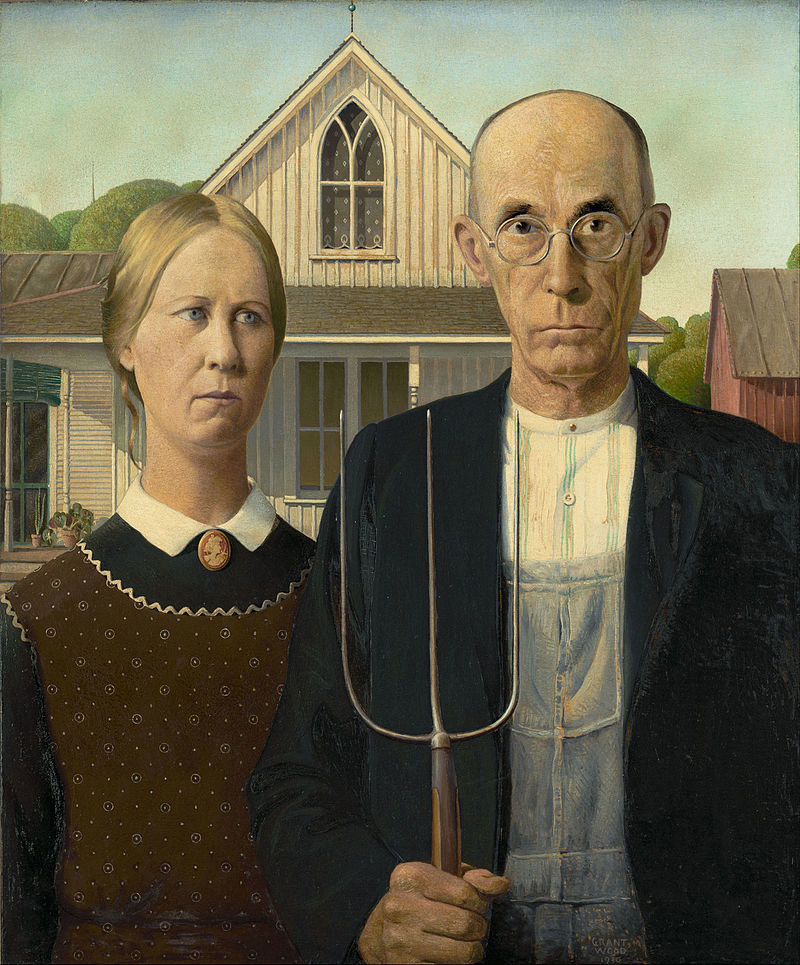American Gothic is an oil-on-beaverboard painting that was created by American painter Grant Wood in 1930. The painting depicts two figures; the one on the right is an elderly man holding a pitchfork while looking directly in front, while the one on the left is a mid-age woman who is wearing a red and gold brooch at the center of her dress’ collar and is looking to the right. In the background is a gothic-style house that is white in color and has a peculiar looking window in front of the second floor. American Gothic is considered as one of the most iconic American paintings, along with Whistler’s Mother by James McNeill Whistler and No.5, 1948 by Jackson Pollock. To know more as to why it became popular, let us take a look at the interesting origin of American Gothic.
Origins and Interpretations
The house depicted on the background of American Gothic was the Dibble House, a small home in Eldon, Iowa that was built to have the Carpenter Gothic architectural style. Grant Wood saw the house for the first time in August 1930, when he was driven around Eldon by John Sharp, a young painter who admired Wood’s paintings, to look for inspiration for his next painting. When Sharp’s brother was asked in 1973 about what happened during that drive, he stated that Wood first sketched the Dibble House on the back of an envelope to have a better idea of how he would paint it. Some historians who chronicled Grant Wood’s life said that Wood had been fond of the house when he first saw it, as he found the gothic-style window on the second floor the house to be quite peculiar.
Wood then asked the permission of the owners of the house, namely Selma Jones-Johnston and her family, to use the house as the background for his painting. When his request was approved, he then thought about the appearance of the people that would live in the lovely house. After setting on the appearance of two people in his mind for the painting, he asked his sister Nan and their family dentist, Dr. Byron McKeeby, to serve as models for his painting. While many people interpreted the two people in the painting as husband and wife, Grant’s sister Nan stated that the two were supposed to be father and daughter. This statement was also strengthened by Grant when he wrote a letter to a woman named Nellie Sudduth saying that the female in the painting is the man’s grown-up daughter.
Grant Wood submitted the painting as a contest piece for an exhibition at the Art Institute of Chicago. In the said exhibit, American Gothic won the bronze medal and a $300 cash prize. However, it wouldn’t have won the prize without the efforts of a museum patron, who admired the painting and persuaded the judges to pick American Gothic to get third place. The same patron also asked the Art Institute of Chicago to buy the painting from Wood, and today, the same institute still has American Gothic in their possession.
American Gothic quickly became a popular painting for the media, and it will eventually appear in various newspapers, including the Chicago Evening Post. When it appeared in another newspaper called Cedar Rapids Gazette, the people of Iowa didn’t like how their state was depicted in the painting. For many Iowans, they believed that the painting depicts how “backward” they appeared compared to others that seem to have embraced the industrialization of the country. However, Wood didn’t intend the painting to be interpreted that way, and in a letter written by him in 1941, he said that those who hated the painting are the ones that feel that they are the ones being depicted in American Gothic when they are actually not.
There are also other interpretations that popped up for American Gothic, and one of the famous interpretations is the notion that the two people depicted in the painting are Grant Wood’s parents. It was believed that Wood got the inspiration for the clothing worn by the two figures when he was looking at an old family album. In addition, the old-fashion clothes would suggest that the painting depicts not the 1930s but an older era. The male figure is supposed to represent his father, who died when Wood was only ten years old, while the female figure represents her mother. An art historian named Sue Taylor suggested that Wood may have developed an Oedipus complex, which prevented him from depicting any affection or attachment between the two figures that represent his parents. Furthermore, Taylor further insisted that the female figure was Wood’s mother when she compared a portrait of Wood’s mother and American Gothic, wherein Taylor found out that both of the females are wearing the same brooch.
Besides personal interpretations that connect Wood’s life with the artwork, there are also interpretations that separate the artist from his art. The most famous symbolization of American Gothic, according to some art experts, is the depiction of the American pioneer spirit, which was an attitude carried by the early Americans that allowed them to build a comfortable home, town, and settlement for their families and for others. The symbolism is further emphasized on the pitchfork that the male figure holds in the painting, as a pitchfork is often used for a variety of manual labor, including picking up hay.


